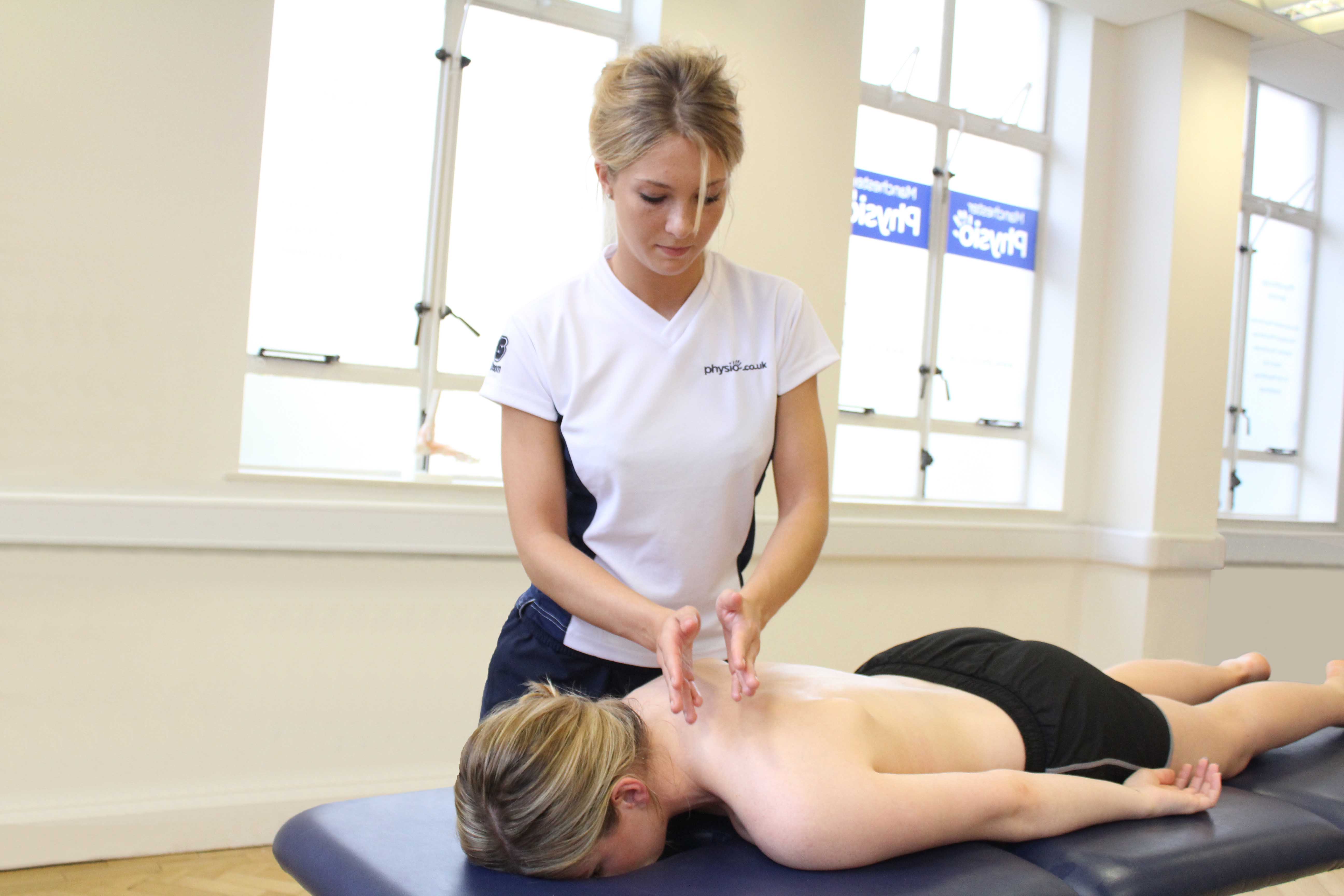- Functional Prosthesis
- Cosmetic Prosthesis
Functional prosthesis
Functional prostheses are either a ?body-powered? prosthesis operated by means of a cable and harness system that recruits the back and shoulder muscles. When the cable is pulled open the hand voluntarily opens or closes allowing a grasping motion. The other type is an ?electric? prosthesis which uses the electric current signals within a muscle contraction (EMG signals) on the residual limb and skin to power the prosthesis to carry out the functions of the elbow, wrist or hand. The power is provided by a battery in the prosthesis. Functional hands are designed to allow different types of terminal devices to be attached.
 Above: Stretches and mobilisations of the shoulder by a specialist massage therapist
Above: Stretches and mobilisations of the shoulder by a specialist massage therapistCosmetic prosthesis
The cosmetic prosthesis will provide no function to the patient but is made to look like a normal arm. This prosthesis will have an endoskeletal design. This means that the prosthesis will be made to look and feel like skin.
Components of a functional above elbow prosthesis
The above elbow prosthesis will be constructed from several different components. These components allow the prosthesis to carry out different functions. The prosthesis should be designed to best suit the individual’s needs and cost. The basic components of an above elbow prosthesis are discussed in more detail below.
- Suspension system
- Socket
- Forearm
- Elbow mechanism
- Arm system
- Wrist unit
- Hand or terminal devices
Suspension systems
The suspension systems main function is to stabilise the prosthesis during movement. Suspension systems can be classified as follows:
Harnessed-based systems are a commonly used suspension systems for many arm amputations. With a simple harness, called figure-8, straps go over each shoulder and criss-cross. This suspension system has proven its reliability during lighter duties. This is a simple device that can be easily adjusted. However, discomfort may be caused as the system does bear weight underneath the shoulder. The harness can be altered to a shoulder saddle and chest strap which provides greater lifting abilities and many users find it more comfortable to the standard figure-8 harness.
Self-suspending sockets can be used with or without a harness strap. Their main advantage is the ease of use. However, they do have a limited lifting capacity compared to the harness system; reduced elbow flexion and are less attractive in appearance.
Suction sockets are the most commonly used systems for above elbow amputation. This system requires full contact with the stump. The skin around the stump needs to be healthy and have limited scarring to avoid the wound weeping or becoming irritated. These systems require a sleeve with a pin locking mechanism. They eliminate the use of straps and are more accommodating to any changes in volume as an extra sock can easily be worn. This system can be more difficult to put on and uncomfortable in hot climates.
Socket
The socket is composed of two different layers. There are two different designs. The first design is a rigid inner socket that is measured and designed to fit the individuals stump. A second layer is designed over this to look like the opposite arm in colour and length. The inner socket provides the function and should be comfortable to wear over long periods of time. The second design has a more flexible inner layer allowing the second layer to provide the support. This enables attachment of various cables and joints as needed to the second layer.
Forearm
The forearm consists of a plastic shell. The forearm attaches to the socket at one end and to the elbow mechanism at the other end.
Elbow mechanisms
Elbow mechanisms are available as either body powered or externally powered devices. They normally attach to the forearm through a turntable allowing the upper arm to rotate.
Arm systems
Arm systems are normally built from plastic. The arm system attaches from the elbow joint to the wrist unit. It acts to stabilise the prosthesis.
Wrist Unit
The wrist unit provides feedback to the location of the hand or terminal device in space. This can be powered manually, by cable power or with external power. The main function of the wrist unit is to facilitate the hand or terminal devices.
Hand or terminal devices
Hand or terminal devices are operated by nylon cords which transmit tension forces by movement in the shoulder. This is the most vital component to the prosthesis as it replaces the arms most important lost function, being able to grasp an object.
Five different types of grips are available with hand or terminal devices. These are as follows:
Precision grip is using the index finger and thumb to pick up a small object(e.g. picking up rice). This is one of the two main grips used with a prosthesis.
Tripod grip is using the pad of the thumb against the pads of the index and middle finger (e.g. using a pencil). This is the other of the two main grips used with a prosthesis.
Lateral grip is using the thumb and side of the index finger. This allows an object to be grasped and turned at the same time (e.g. key in the door).
Hook power grip is when the fingers are bent whilst keeping the thumb straight (e.g. handle on a briefcase).
Spherical grip is when the tips of the fingers and thumb are bent (e.g. opening a doorknob).
Summary
Whichevertype of prosthesis you have, you will benefit from physiotherapy input. If you would like to arrange an assessment with one of our physiotherapist please call Physio.co.uk on 0330 088 7800. You can also book an appointment online today!

 0330 088 7800
0330 088 7800


































